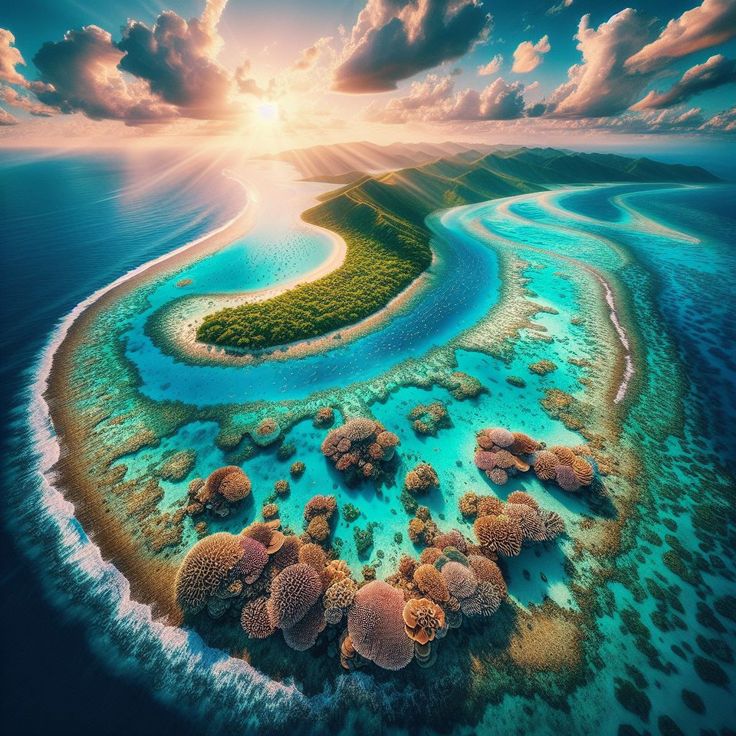The Great Barrier Reef, Australia: 7 Astonishing Facts About Its Natural Beauty and Global Significance
The Great Barrier Reef, one of the most awe-inspiring natural wonders of the world, is located off the coast of Queensland, Australia. This vast and vibrant ecosystem is home to an incredible array of marine life and serves as a vital part of the global environmental balance. Whether you’re an avid traveler, marine enthusiast, or environmental advocate, understanding the history, significance, and daily impacts of the Great Barrier Reef will leave you in awe. In this article, we’ll explore the biography of the Great Barrier Reef, its impact on daily life, key facts, and the importance it holds for society and the planet.
A Brief History
It was formed millions of years ago during the rise of sea levels and changing environmental conditions. Stretching over 2,300 kilometers (1,430 miles), it consists of over 2,900 individual reefs and around 900 islands, making it the largest coral reef system in the world. Its creation began about 20 million years ago, when coral polyps started building the reef structure through their natural processes.
The reef has evolved over time, with many of its corals being some of the oldest living organisms on Earth. The Great Barrier Reef was first recognized by Europeans in 1770 when Captain James Cook sailed along its shores during his expedition to the Pacific. Over the centuries, the reef has become a symbol of Australia’s natural beauty and a significant destination for tourists from around the world.
Daily Life Impacts
The daily life of people living near the Great Barrier Reef is deeply intertwined with this natural wonder. The reef directly affects the livelihoods of many who rely on it for fishing, tourism, and research. Local communities around the reef often depend on the biodiversity it provides for their food sources and economies.
1. Economic Contributions: The Great Barrier Reef generates billions of dollars annually for Australia’s economy, with tourism being one of the primary sources of income. Tourists flock to the region for scuba diving, snorkeling, and boat tours to see the colorful coral, sea turtles, and diverse marine species. The reef supports over 60,000 jobs in Queensland alone, making it a critical economic asset for the country.
2. Fishing Industry: Many local fishermen rely on the reef’s abundant marine life to support their businesses. The reef provides a rich habitat for a variety of fish, shellfish, and crustaceans, which are harvested for both local consumption and export.
3. Indigenous Communities: Indigenous Australian communities, such as the Traditional Owners of the Reef, have lived in the region for thousands of years. The reef is central to their cultural identity and spiritual beliefs. They have a deep understanding of the reef’s ecology and have historically used sustainable fishing practices to care for the environment.
4. Environmental Stewardship: As caretakers of the reef, environmental scientists and marine biologists dedicate their daily efforts to studying and preserving the ecosystem. Their work is vital for understanding the impacts of climate change, pollution, and human activity on the reef’s delicate balance.
Fascinating Facts About
- Largest Living Structure: The Great Barrier Reef is the largest living structure on Earth, visible even from space. It is made up of millions of individual coral polyps working together to form a complex, interconnected ecosystem.
- Unparalleled Biodiversity: The reef is home to an astonishing variety of marine life, including over 1,500 species of fish, 411 types of hard coral, 30 species of whales and dolphins, and 6 species of sea turtles. It also provides a habitat for several endangered species, such as the dugong and green sea turtle.
- Coral Bleaching Crisis: In recent years, the Great Barrier Reef has suffered from coral bleaching, a phenomenon caused by rising ocean temperatures due to climate change. Bleaching occurs when corals expel the algae living within them, causing them to turn white and jeopardize their health. This environmental crisis poses a threat to the reef’s long-term survival.
- World Heritage Status: The Great Barrier Reef was designated a UNESCO World Heritage site in 1981 due to its outstanding universal value. This status helps to protect and preserve the reef for future generations by limiting certain human activities and promoting conservation efforts.
- Marine Protected Areas: A significant portion of the Great Barrier Reef is designated as a marine park, offering protection from activities like fishing and mining. The Great Barrier Reef Marine Park Authority oversees the management and conservation of the reef, working to balance human use with environmental protection.
- Tourism and Conservation: Tourists visiting the Great Barrier Reef are encouraged to participate in eco-friendly practices, such as avoiding touching the coral or feeding the fish. Many tour operators are committed to sustainability and educate visitors about the importance of preserving this natural wonder.
- Vital Role in Climate Regulation: The reef plays a crucial role in the global climate system. Coral reefs act as carbon sinks, absorbing large amounts of carbon dioxide from the atmosphere. This helps to mitigate climate change by reducing the amount of greenhouse gases in the air.
The Significance
The Great Barrier Reef is not just a national treasure; it holds global significance. It is a key player in the health of our oceans and the overall well-being of the planet. Here are some of the key ways it impacts society and the environment:
1. Environmental Balance: The reef serves as a critical ecosystem that helps to regulate marine biodiversity. Its diverse marine life supports a food chain that benefits many other species, both in the ocean and on land. Coral reefs also protect coastlines from erosion and reduce the impact of storms and waves.
2. Climate Change and Carbon Sequestration: As mentioned earlier, the Great Barrier Reef plays an important role in regulating the climate by acting as a carbon sink. The coral polyps absorb carbon dioxide, helping to mitigate the effects of climate change. By protecting the reef, we are also protecting our planet’s future.
3. Educational and Scientific Value: The Great Barrier Reef is a living laboratory for scientists studying marine ecosystems. The reef provides invaluable insights into marine biology, climate change, and ecological balance. Its biodiversity offers opportunities for medical and pharmaceutical discoveries, as marine organisms often contain compounds with healing properties.
4. Tourism and Global Awareness: The reef is one of Australia’s most popular tourist destinations, attracting millions of visitors each year. This tourism helps raise awareness about the need to protect the environment and the consequences of human activities on fragile ecosystems.
FAQs
Q: Can you visit?
A: Yes, the Great Barrier Reef is one of the most visited natural attractions in the world. Tourists can visit by boat, helicopter, or by diving and snorkeling in the protected areas. Eco-friendly practices are encouraged to minimize environmental impact.
Q: How does climate change affect the reef?
A: Climate change leads to rising ocean temperatures, which causes coral bleaching and weakens the reef’s resilience. The increase in ocean acidification also makes it harder for corals to build their skeletons, leading to further degradation of the reef.
Q: What is being done to protect?
A: Efforts are underway to protect the reef through conservation programs, marine protected areas, sustainable tourism practices, and addressing climate change. Governments, organizations, and local communities are working together to preserve this natural wonder for future generations.
Conclusion: The Lasting Legacy
It is not just a natural wonder of Australia but a symbol of the delicate balance between humanity and the environment. It offers breathtaking beauty and endless opportunities for discovery, but it also serves as a reminder of the importance of environmental stewardship. By understanding the significance of the reef, its daily impacts, and the challenges it faces, we can all contribute to preserving this incredible ecosystem for future generations. If you ever have the chance to visit, you’ll witness firsthand the awe-inspiring grandeur of the Great Barrier Reef and the urgency with which we must protect it.
Wishing for a Greener Tomorrow: Let us all wish for a future where the Great Barrier Reef thrives, providing beauty, balance, and prosperity for all who call Earth home.










